
Newtownards is a town in County Down, Northern Ireland. It lies at the most northern tip of Strangford Lough, 10 miles (16 km) east of Belfast, on the Ards Peninsula. It is in the civil parish of Newtownards and the historic baronies of Ards Lower and Castlereagh Lower. Newtownards is in the Ards and North Down Borough. The population was 29,677 in the 2021 Census.

County Down is one of the six counties of Northern Ireland, one of the nine counties of Ulster and one of the traditional thirty-two counties of Ireland. It covers an area of 961 sq mi (2,490 km2) and has a population of 552,261. It borders County Antrim to the north, the Irish Sea to the east, County Armagh to the west, and County Louth across Carlingford Lough to the southwest.
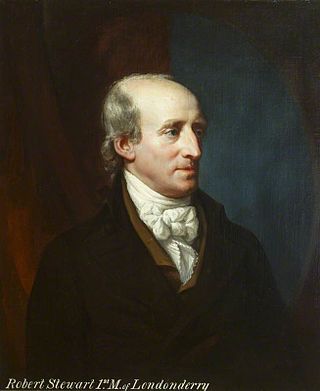
Robert Stewart, 1st Marquess of LondonderryPC (Ire) (1739–1821), was a County Down landowner, Irish Volunteer, and member of the parliament who, exceptionally for an Ulster Scot and Presbyterian, rose within the ranks of Ireland's "Anglican Ascendancy." His success was fuelled by wealth acquired through judicious marriages, and by the advancing political career of his son, Viscount Castlereagh. In 1798 he gained notoriety for refusing to intercede on behalf of James Porter, his local Presbyterian minister, executed outside the Stewart demesne as a rebel.
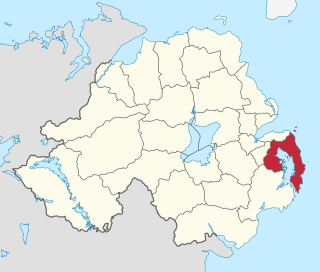
Ards was a local government district in Northern Ireland with the status of borough. It was one of twenty-six districts formed on 1 October 1973, and had its headquarters in Newtownards. It was merged with neighbouring North Down on 1 May 2015 to form the new Borough of Ards and North Down. Other towns in the defunct Borough included Portaferry, Comber, and Donaghadee, and the population of the area was 78,078 according to the 2011 census.
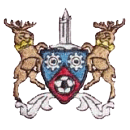
Ards Football Club is a semi-professional, Northern Irish football club playing in NIFL Championship. The club is based in Newtownards, but plays its home matches at Clandeboye Park in Bangor, which it rents from rivals Bangor to play home games. The club colours are red and blue.

Bangor Castle is a country house situated in Castle Park in Bangor, County Down, Northern Ireland. The building, which is also referred to as Bangor Town Hall and is now used as the offices of Ards and North Down Borough Council, is a Grade A listed building.

Scrabo Tower is a 135 feet (41 m) high 19th-century lookout tower or folly that stands on Scrabo Hill near Newtownards in County Down, Northern Ireland. It provides wide views and is a landmark that can be seen from afar. It was built as a memorial to Charles Vane, 3rd Marquess of Londonderry and was originally known as the Londonderry Monument. Its architectural style is Scottish Baronial Revival.

Mount Stewart is a 19th-century house and garden in County Down, Northern Ireland, owned by the National Trust. Situated on the east shore of Strangford Lough, a few miles outside the town of Newtownards and near Greyabbey, it was the Irish seat of the Stewart family, Marquesses of Londonderry. Prominently associated with the 2nd Marquess, Robert Stewart, Viscount Castlereagh, Britain's Foreign Secretary at the Congress of Vienna and with the 7th Marquess, Charles Vane-Tempest-Stewart, the former Air Minister who at Mount Stewart attempted private diplomacy with Hitler's Germany, the house and its contents reflect the history of the family's leading role in social and political life in Britain and Ireland.

The Local Government Act 1972 was an Act of the Parliament of Northern Ireland that constituted district councils to administer the twenty-six local government districts created by the Local Government (Boundaries) Act 1971, and abolished the existing local authorities in Northern Ireland.

Northern Ireland is divided into six counties, namely: Antrim, Armagh, Down, Fermanagh, Londonderry and Tyrone. Six largely rural administrative counties based on these were among the eight primary local government areas of Northern Ireland from its 1921 creation until 1973. The other two local government areas were the urban county boroughs of Derry and Belfast.
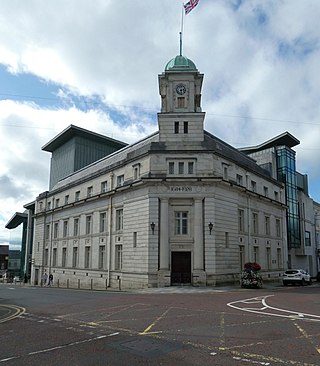
Ballymena Town Hall is a municipal structure in Bridge Street in Ballymena, County Antrim, Northern Ireland. The town hall, which is the headquarters of Mid and East Antrim Borough Council, is a Grade B1 listed building.
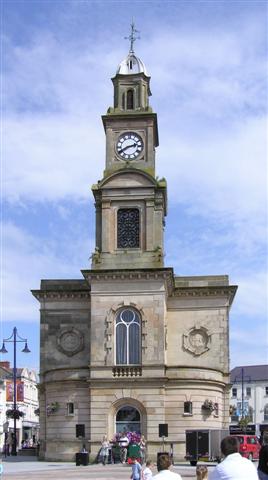
Coleraine Town Hall is a municipal structure in The Diamond in Coleraine, County Londonderry, Northern Ireland. The town hall, which was the headquarters of Coleraine Borough Council, is a Grade B1 listed building.
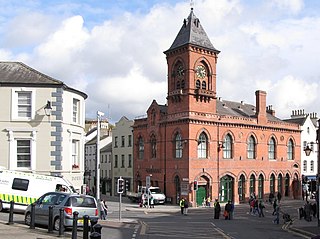
The Down Arts Centre, formerly Downpatrick Town Hall and also Downpatrick Assembly Rooms, is a municipal structure in Irish Street in Downpatrick, County Down, Northern Ireland. The structure, which was the meeting place of Down Urban District Council, is a Grade B1 listed building.

The Old Town Hall is a municipal structure in Scarva Street in Banbridge, County Down, Northern Ireland. The structure, which currently accommodates a Community Advice Centre on the ground floor and a room for local community groups on the first floor, is a Grade B1 listed building.

The Roe Valley Arts & Cultural Centre, formerly the Alexander Memorial Hall and originally Limavady Town Hall, is a civic venue in Main Street in Limavady, County Londonderry, Northern Ireland. The structure, which incorporates the façade of the old town hall, was previously a Grade B1 listed building but was delisted in July 1998 to facilitate the demolition of the structure behind the façade and the subsequent erection of a new cultural centre.

Ballyclare Town Hall is a municipal structure in The Square, Ballyclare, County Antrim, Northern Ireland. The structure, which is primarily used as an events venue, is a Grade B2 listed building.
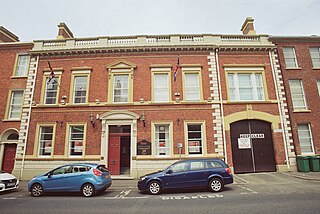
The Old Town Hall is a municipal structure in Castle Street, Lisburn, County Antrim, Northern Ireland. The structure, which is used as a constituency office by the Democratic Unionist Party, is a Grade B2 listed building.
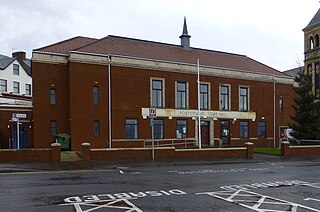
Portstewart Town Hall is a municipal structure in The Crescent, Portstewart, County Londonderry, Northern Ireland. The structure, which has been closed to the public since December 2019, is a Grade B2 listed building.




















